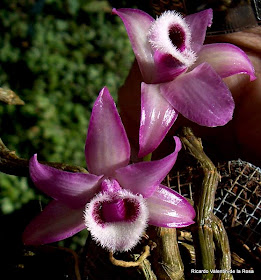This species is native of a wide band of Asia, it can be found from the Assam region of India to China, Thailand, Myanmar, Laos and Vietnam. It grows grows in deciduous forest that undergo seasonal variations that dictate a wet and cloudy summer and a dry and sunny winter. This variations in water availability and light intensity are said to promote better blooming when some effort is made to replicate them in captivity. The flowers have a powerful, pleasing fragrance.
This Dendrobium seems to grow poorly locally. Most of the plants I have seen on display are literal dwarves when compared with similar plants grown in more temperate climates. In my own experience this is a plant that is difficult to keep and can be prone to rot if put in a growing media with poor aireation. None of my plants have produced canes that have reached more than five or six inches. However when grown in well drained media or in a plaque of cork or fern the plant can be problem free. It has also grown relatively well in very small pots that have good drainage. One of my best plants was grown on a two inch pot for several years with little complaint.
The canes can be straight or arching, I have had plants that have grown both ways. It responds well to daily watering and heavy fertilization during its growing season. However it can be perceived as a frustratingly slow grower for those of us accustomed to plants such as anosmum and cucullatum which can grow a five to seven feet cane in a single season.
This plant is very common in horticulture and even the most cursory Internet search can reveal several growers that have it for sale at very affordable prices. Locally I have seen this plant only on the collections of the more experienced hobbyists. It is not clear if the relative rarity of this species locally is because the more experienced hobbyists are the only ones that are interested in it or whether they are the only ones that can keep it alive for an extended period of time.




No comments:
Post a Comment